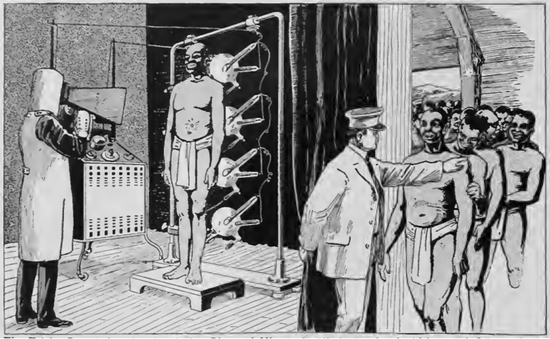X-ray inspection of South African diamond miners as illustrated in the April 1919 issue of Electrical Experimenter

New technologies can do a tremendous amount of good. They can help us travel faster and farther, access information more quickly, and diagnose life-threatening diseases. But those same technological tools that accomplish wonderful things for the benefit of humanity can just as easily become the weapons of war, the spreaders of disease, and the tools of oppression. In 1919, X-ray technology found itself in the latter camp when it was used to inspect miners in the diamond-rich area of Kimberley, South Africa. Specifically, X-rays were used to see inside the black workers in the search for diamonds some were suspected of taking from white-controlled mines. Each day the miners would have to strip naked to be inspected. Some miners would swallow diamonds, or even hide them in self-inflicted incisions in their legs. But one diamond mine had the idea of using X-rays to find diamonds that couldn’t be found through a simple strip search. The April 1919 issue of Electrical Experimenter magazine explained the process that the managers of the mines had set up:
One of the successful schemes which has been worked out by the superintendent of a large South African diamond mine is shown in the accompanying illustration, and it involves the use of a powerful X-ray machine having several X-ray bulbs excited simultaneously. As each miner passes before the X-ray bulbs, the examiner looks thru his fluoroscope and rapidly swings it up and down, so as to take in the entire body in a few seconds. This system of detecting the presence of a diamond, no matter whether it is buried in the flesh, resting in a throat cavity, or even in the stomach—an almost unbelievable practise resorted to in several instances on record—the X-ray examination quickly indicates the presences of the diamond.
Today we think of the X-ray within the context of the medical profession. But with each new discovery, invention and innovation there comes both potential for abuse and unintended consequences. Despite the great promise of the X-ray, its history was sketchy from the beginning. For decades after the X-ray’s discovery in 1895 by Wilhelm Roentgen (they were originally called Roentgen rays), X-ray experiments harmed many people. These early experimenters like Walter James Dodd, H.D. Hawks, Thomas Edison, and Nikola Tesla didn’t understand the damage they were doing to their own bodies until they’d already been exposed to harmful levels of radiation. But even after the harm from prolonged and intense exposure to X-rays was recognized, it wasn’t used solely for medical purposes to aid those afflicted with a particular ailment. These days, even annual X-rays looking for dental cavities or lung cancer are being re-evaluated for their risk-reward ratio. X-rays don’t have an opinion about how they’re used, but their use (just like any other technology) always has consequences—good or evil; intended or unintended.





